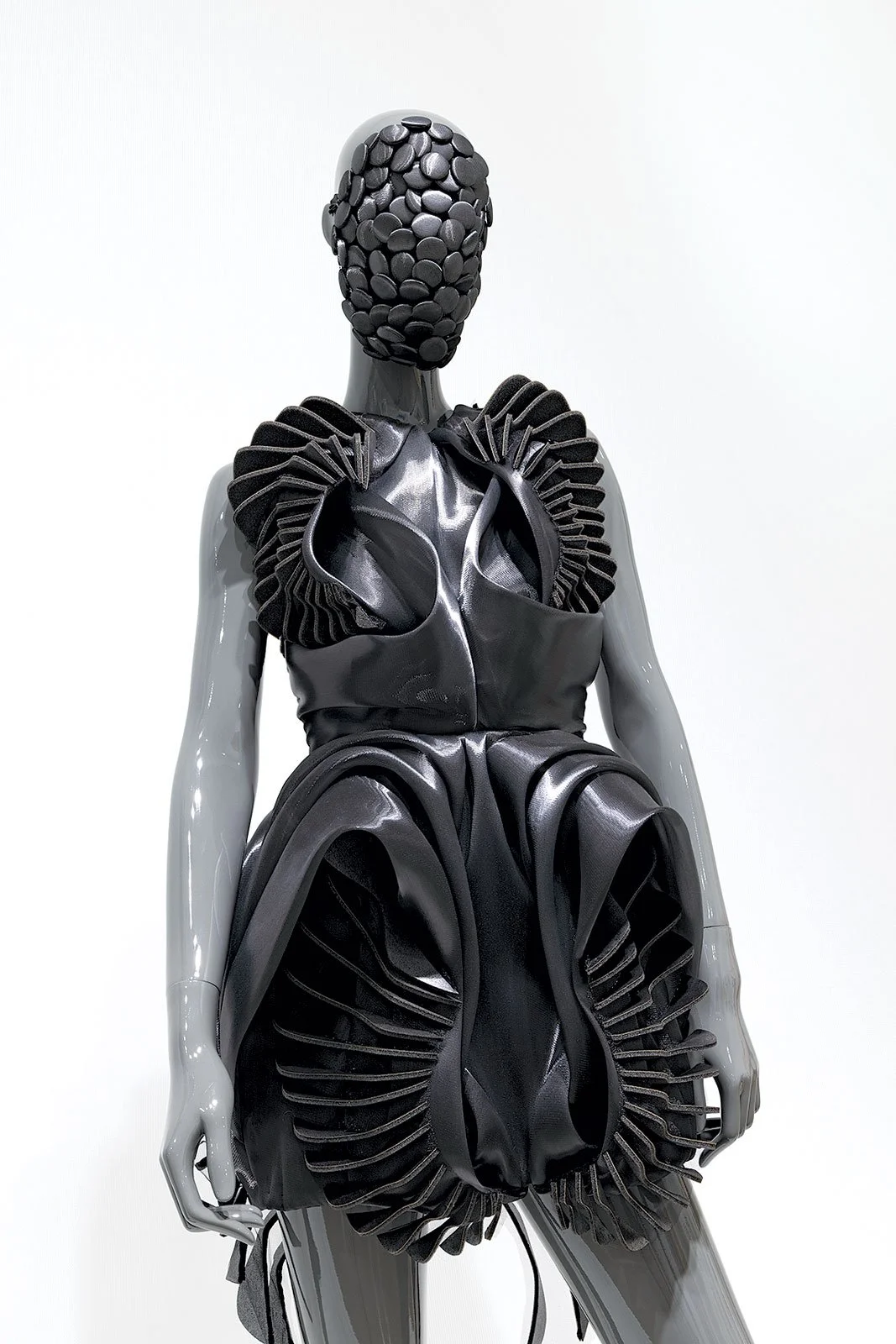Future Imaginaries Volume 46.2
Blending fashion, sci-fi and ecology, “Future Imaginaries: Indigenous Art, Fashion, Technology” at the Autry Museum of the American West brings together contemporary artists and designers from a wide spectrum of Native cultures across North America. Together, they look forward—and back—in a circular continuum that upends the traditional role of the museum, holding up a funhouse mirror to the past and future.
Like its better-known counterpart, Afrofuturism, indigenous futurism emerged from the social activism of the 1970s—specifically Red Power and the American Indian Movement. It envisions superheroes and space operas that draw on Native history and culture, carving out spaces for ancestral knowledge and social justice in an increasingly technological society. In these wildly imaginative visions of the future, there is not just liberation but restoration of sovereignty; historic and modern woes—colonialism, climate change, poverty—are conspicuous by their absence.
While contemporary American sci-fi is often set in dystopian futures—shadowy wastelands born of environmental destruction and totalitarian politics—indigenous futures are bright. As artist Rose Simpson explains, the idea of apocalypse is less threatening to Native communities: “In a sense … indigenous people have been at a privilege when it comes to any kind of hardship because we’ve already survived.” The apocalypse—contact with European settlers and colonization—has already happened, bringing not only the loss of life but, in many cases, the loss of a whole way of life. By contrast, the future offers “an opportunity for innovation and for reflection and renewal.”
The exhibition occupies a large but crowded gallery, spilling out into other corners of the museum. It encompasses weaving, clothing, jewelry, video, woodwork, metalwork, interactive sculpture, and comic book art. On display for a generous two years, it includes new, site-specific works like Stirs Up the Dust by Wendy Red Star, part of a series of 3D installations placing indigenous figures in surreal spacescapes, wearing otherworldly regalia.
TEMPEST designed by Sonny Assu (Ligwilda’xw of the Kwakwaka’wakw Nations) of wool and cotton jacquard tapestry woven by Sophia Borowska, 2023. The textile is one of four conceptualized by Assu after he visited the Ottawa Institution to view and hold the Chilkat robe, dance apron and frontlet that belonged to his great-great-grandfather, Hereditary Chief Billy Assu. His grandmother, MItzi Assu, provided the letter to the museum requesting that her grandson was granted access. Photograph by Patrick R. Benesh-Liu.
Click to Enlarge
REGALIA NAAMOI’STOTOOHSIN (Bumblebee Regalia) by Adrian Stimson (Siksika) and Lucille Wright Payotapaihpiyakii (Siksika) of fur leggings, coveralls, headgear, beaded gloves and moccasins, dancing stick with leather, bird talon, shell horsehair, ribbon, feathers, and painted bison rawhide shield, 2021. Stimson collaborated with beadwork artist Payotapaihpiyakii (Dancing the opposite direction woman) to reimagine the beekeeper’s suit as a resplendent regalia. AICHA’S REGALIA from the series Echoes from a Near Future by Caroline Monnet (Anishinaabe/French) of floor underlayment (reflective coating for laminate flooring), 2022. WATHÉCA from the Future Ancestral Technologies project by Cannupa Hanska Luger (Mandan/Hidatsa/Arikara/Lakota) of mixed media, ceramic, repurposed materials, 2021. Photographs by Patrick R. Benesh-Liu.
FOSSIL 2.0 WITH PEBBLE MASK by Jontay “Kahm” Kahmakoatayo of organza twill, 2023. Image Courtesy of Autry Museum. Photograph by Mitokino.
“Indigenous peoples have been adorning themselves with custom clothing and regalia for centuries in ways that are at once functionally practical, visually beautiful, and continuous with ancestral knowledge and cultural identity,” the curators write. Mannequins dressed in a mix of fashion, wearable art, and stylized regalia and ribbon skirts open the show, some of the pieces accompanied by videos showing the garments in motion. Cannupa Hanska Luger’s buzzard-like regalia made from recycled materials celebrates one of nature’s scavengers, well-equipped to survive an apocalypse with style and sustainability.
Adrian Stimson’s Bumblebee Regalia takes the form of a beekeeper’s suit, combatting the loss of pollinators due to colony collapse. It is crafted from more than three hundred beaded bees as well as materials from endangered species found on Siksika Nation land—great horned owl feathers, hawk talons, polar bear fur—and from nonendangered animals like porcupine, moose, abalone, bison, and deer, painting a cautionary picture of precarious survival. Similarly, historic and contemporary materials blend in Jeffrey Gibson’s Tribes File Suit to Protect Bears Ears, a shimmering jingle dress mounted on tipi poles that is designed to double as a protective shelter for environmental activists during protests, like the ones that successfully defended Bears Ears National Monument in Utah.
Other garments on display are runway pieces, though they may incorporate traditional or recycled materials and intergenerational motifs. Jontay Kahm, a Plains Cree designer sometimes called the indigenous Alexander McQueen, contributes a spooky-chic little black dress inspired by the anatomical architecture of fossils. Multidisciplinary artist Caroline Monnet uses recycled construction materials (like laminate flooring and Tyvek, their industrial logos intact) to create sculptural “body-habitats”—simultaneously addressing housing inequity in Native communities and the environmental cost of the built environment.
Click to Enlarge
SHE in Light Form from the series No Pigs in Paradise by Nep Sidhu (Punjabi Sikh) and Nicholas Galanin (Tlingit/Unangax) of melton wool, jute, silver zari, chenille, cotton, 2016. WARRIOR TWINS COAT by Orlando Dugi (Diné) in collaboration with Ryan Singer (Diné) of silk/wool blend, silk charmeuse, gold flat metal wire, French bullion, and silk dye, 2022. ANTI-PIPELINE SOCIETY KWE from the wearable art series Material Kwe by Celeste Pedri-Spade (Anishinaabekwe [Ojibwe]) of fabric, ribbons, leather belt, brass tacks, metal jingle bells, and horsehair, 2019; TRIBES FILE SUIT TO PROTECT BEARS EARS by Jeffrey Gibson (Mississippi Band of Choctaw Indians/Cherokee descent) in background. Photographs by Patrick R. Benesh-Liu.
Unlike the acclaimed 2015 touring exhibition “Native Fashion Now,” the exhibition focuses on futuristic clothing. But the J. Paul Getty Museum staged a full-scale runway show to mark the opening, with roughly fifty looks from five of the designers represented in the Autry’s gallery: Jason Baerg, Orlando Dugi, Jontay Kahm, Caroline Monnet, and Jamie Okuma. (“Future Imaginaries” is part of The Getty’s 2024 initiative PST ART: Art & Science Collide.) It gave a select group of Angelenos a thrilling taste of Native Fashion Week, the annual happening in Santa Fe. While many of these designers have appeared in the pages of glossy fashion magazines, they are not necessarily striving for mass-market success, preferring to create luxe, handmade, one-of-kind pieces with a small environmental footprint using traditional techniques. As Okuma told Vogue: “When I was younger, I wanted to go mainstream, meaning being just a designer—not a native designer. Now, I realize that’s not a bad thing. In a world where we are not supposed to be labeling, I feel I need to embrace it. Nobody can do indigenous design better than we can.”
Cases display small accessories and jewelry, including Catherine Blackburn and Rykelle Kemp’s Swarovski-studded bison-horn headdress. Metalsmith Pat Pruitt’s Armor of the Ice Infantry, a scaled breastplate of titanium and leather created for the exhibition, recalls both water and medieval chain mail. Okuma, known for her “indigenized” takes on luxury brands, contributes a pair of Christian Louboutin boots entirely hand-beaded with antelopes and flowers. Other artists “indigenize” Air Jordans, or a pair of leather Derby shoes “embroidered” with flowers fashioned from circuit boards, capacitors and other electronic components in the style of moccasins, updating the role of embroidery in “encoding” indigenous knowledge and history. Elsewhere in the gallery, Gold Star Quilt by Wally Dion riffs on the Northern Plains star quilt pattern, replacing the cozy materials with shiny, sharp computer hardware.
Click to Enlarge
BEADED HIGH HEEL BOOTS by Jamie Okuma (Luiseño/Shoshone-Bannock) of hand-beaded Louboutin boots and animal fur stuffing, 2011. Photograph by Patrick R. Benesh-Liu. ARMOR OF THE ICE INFANTRY: PROTECTORS OF THE WATER by Pat Pruitt (Laguna Pueblo) of titanium and leather, 2024. This piece was made especially for the exhibit. Courtesy of The Autry Museum of the American West. NIGIK MAKIZINAN-EFFACE by Barry Ace (Odawa) of found shoes, vintage wooden shoe stand, vintage round circuit board, coated wire, capacitors, light-emitting diodes, resistors, vintage wooden shoe lasts, and metal hardware, 2017. Photograph by Patrick R. Benesh-Liu.
The exhibition’s second section, “Indigenizing Sci-Fi,” draws on familiar pop culture figures like Stormtroopers, Yoda and the Starship Enterprise. Artists including Andy Everson, Ryan Singer and Neal Ambrose Smith do more than project indigenous iconography onto their boyhood heroes; they question and wittily remix American conceptions of technology, aliens and the meaning of time. Of course, science fiction itself has long borrowed (or, more accurately, appropriated) imagery from indigenous communities, including Avatar’s Na’vi and Princess Leia’s Hopi hairstyle. Everson’s Stormtrooper helmet, inspired by Chilkat weavings, conjures up a different kind of warrior: the tribal guardians of the Pacific Northwest. Another quilt, Trek (Pleiades) by Marie Watt, overlays diamond patterns found in traditional Native basketry with a stitched outline of the Starship Enterprise, evoking mythic and futuristic voyages through time and space.
Time travel is a recurring trope; these pieces challenge “the idea that time is linear,” co-curator Kristen Dorsey writes in the exhibition catalogue. Just as regalia might be passed down through generations—and, with it, ancestral knowledge, power and protection—the images, themes and materials of indigenous futurism echo from past to future, promising continuity and, ultimately, resilience.
NORTHERN WARRIOR by Andy Everson (Comox/Kwakwaka’wakw) of ABS plastic, rubber trim, cast resin, turned maple (hat), clear smoky acrylic, paint, 2014. Photograph by Patrick R. Benesh-Liu.
Click to Enlarge
TRANSFORMATION MASK (Profile/Frontal View) by Shawn Hunt (Heiltsuk) of mixed media including acrylic, resin, LED lights, and Microsoft HoloLens, 2017. Photographs by Patrick R. Benesh-Liu.
THEY HAVE BOTH COFFEES by Ryan Singer (Diné) of acrylic on canvas, 2023. This title wordplay comes from the coffee stand in the background, which has a sign in two Diné dialects. The Tusken Raider with a snow cone in the foreground is emblematic of Star Wars, and sympathetically represents an indigenous community committed to protecting their native lands. Photograph by Patrick R. Benesh-Liu.
SUGGESTED READING
Scott, Amy (ed). Future Imaginaries: Indigenous Art, Fashion, Technology. Seattle: University of Washington Press, 2024.
Karen Kramer et al. Native Fashion Now: North American Indian Style. London: Prestel Publishing, 2015.
“Future Imaginaries: Indigenous Art, Fashion, Technology” is on view through June 21, 2026 at the Autry Museum of the American West, Griffith Park, 4700 Western Heritage Way, Los Angeles, California 90027. A catalogue edited by Amy Scott is available from the University of Washington Press. Visit their website at www.theautry.org.
Related Reading
Exhibition
Meticulous Geometry
Kimberly Chrisman-Campbell is a Los Angeles-based fashion historian, curator and journalist, and a frequent contributor to Ornament. Her most recent book is Skirts: Fashioning Modern Femininity in the 20th Century. With her curiosity piqued by the “Future Imaginaries” show at the Autry Museum in Los Angeles, Chrisman-Campbell arrived to find an imaginative representation of a hopeful future. Native futurism parallels the recent artistic movement of Afrofuturism, where artists and creative people picture a future where everyone can thrive. Drawing from pop culture, Indigenous traditions as well as environmental science and activism, the work in “Future Imaginaries” expands what being Native American means.
















